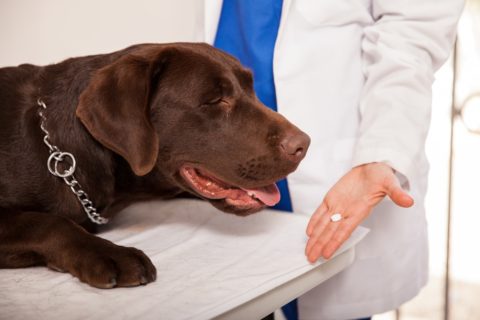As the weather warms up, many dog parents may find themselves contending with watery eyes, a congested nose and itchy skin: classic signs of seasonal allergies. But what you might not know is that dogs can suffer from both seasonal and food allergies, just like humans can.
Allergies are a chronic disease that occurs when the body’s immune system—whether human or canine—sees a common substance as harmful and overreacts to it. Main categories of allergens (or the substances that trigger the allergic reaction) include food, pollen, medicine, insect bites and stings and both biological and synthetic materials (such as latex or mold). As the body tries to get rid of the substance, skin, digestive and/or respiratory symptoms may develop.
Unfortunately, there’s no cure for allergies in dogs or dog parents. However, there are plenty of steps you can take to alleviate your pup’s discomfort. Read on to discover the main types of allergies in dogs, what symptoms to look out for and how to ease allergic reactions.
Investigate the environment.
Just like humans, dogs may experience seasonal allergies in response to environmental factors such as tree, grass and weed pollens, as well as mold spores. Dust and house dust mites can also trigger allergic reactions, as can dander, feathers and cigarette smoke. Just like humans, your dog may also experience an allergic reaction if stung by a bee or another insect.

Get rid of fleas, please.
On a similar note, both fleas themselves and flea-control products can cause allergic reactions in dogs. Flea bites are naturally itchy, but they usually clear up on their own within a week or two. If your pup keeps scratching at flea bites for weeks on end, that could be a sign he’s having an allergic reaction. On the flipside, other dogs are allergic to flea-control medication, as well as other prescription drugs. So if you’re treating your dog for fleas, keep an eye out for the symptoms outlined below.
Review your pup’s diet.
Dogs can also be allergic to various ingredients in food, such as beef, chicken, pork, corn, wheat or soy. While it can be hard to tell the difference, it’s important to note that food allergies are not the same as food sensitivities (a.k.a. food tolerances). Food allergies involve an immune response, whereas food sensitivities are a gradual reaction to an ingredient that disagrees with your pup’s digestive system. However, in both cases your dog might need to experiment with a specialized diet, such as dog treats and food that don’t contain soy, for example.

Consider contact causes.
Finally, dogs can show signs of allergies if their skin comes into contact with a variety of materials, including perfumes, cleaning products, fabrics, insecticidal shampoo and rubber and plastic materials. (Of course, dogs may also sneeze in response to vapors from perfumes and cleaning products, even if they don’t touch them.) Such materials should be kept out of your pup’s reach anyway—you don’t want him to ingest them!—but be extra careful when using them around the house and keep an eye out for allergic symptoms.
Watch for telltale symptoms.
As a dog parent, you’re the first line of defense in identifying symptoms of an allergic reaction in your dog, so know what to look out for. Some canine symptoms are similar to that of humans with allergies: itchiness; hives; red, inflamed skin; swelling in the face or ears; sneezing; and chronic ear infections. Some dogs may also experience diarrhea or vomiting, constantly lick or scratch themselves or chew their paws.

Use the process of elimination.
If you notice your dog engaging in any of the above behaviors, talk to your vet. In all likelihood, your vet will want to identify the allergen(s) through the process of elimination or getting rid of each possible cause one by one until symptoms decrease. This might entail switching to a different flea-control medication or other prescription, or cutting problematic ingredients out of your dog’s diet by trying out grain-free treats and food.
Look into an allergy test.
If the process of elimination doesn’t work, your dog can get an intradermal skin test, which is also given to humans with allergies. The test involves injecting various possible allergens into the skin and seeing which ones cause hives, a classic sign of an allergic reaction. If your dog has moderate to severe allergies, this test can help you and your vet pinpoint the cause of her misery—the first step towards getting relief.

Just say no to allergens.
After you identify the cause of the symptoms, the first step in helping your pup feel better is keeping her away from the allergen as much as possible. In some cases, this is an easy fix, such as switching cleaning products. But if your dog is allergic to something more common—say, chicken or fleas—the solution may involve some lifestyle changes for both of you.
Limit your dog’s exposure.
If cutting the allergen out of your dog’s life isn’t an option, there are still steps you can take to reduce exposure to allergens. For example, if your pup is allergic to grass, you can wipe down his legs with grooming wipes to reduce itching and other reactions. If getting a bath is the symptom trigger, try switching shampoos to something that’s more hypoallergenic, or maybe even a gentle medicated body wash.
Explore medical options.
Medical options are also available if your pup is truly miserable and other interventions aren’t working. Your vet can prescribe an antihistamine, then level up to corticosteroids if the antihistamine doesn’t work. Antihistamines don’t work for all dogs and can lose effectiveness over time, but corticosteroids can have undesirable side effects, so they’re usually only recommended for a short course of treatment. Your vet will be able to advise you on the best course of treatment for your dog.

Consider doggie allergy shots.
If your dog isn’t responding to any other treatment, you can try immunotherapy, the fancy word for allergy shots. After your dog undergoes the intradermal skin test, your vet will formulate a shot made of tiny amounts of the known allergen. Over time, this treatment can help decrease symptoms and allergic reactions. If you don’t like the idea of giving your dog shots, there’s a new procedure called sublingual immunotherapy (SLIT) that allows your dog to take the allergens in pill form instead.
It can be difficult to watch your best furry friend suffer from allergies but these 11 steps can put you on the path to getting a diagnosis and alleviating your pup’s symptoms. Keep a sharp eye out for symptoms, enlist the help of your vet and don’t forget that there are many courses of treatment available to help your pup.
